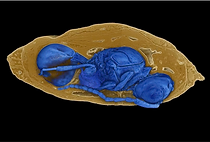Science and Health Writing
A selection of news stories, features and Q&As I've reported.
View my complete portfolio for The New York Times, STAT, and The Atlantic.
Feature Articles
*Winner of the 2023 June L. Biedler Prize for Cancer Journalism
*Winner of the 2021 Evert Clark/Seth Payne Award for Young Science Journalists
*Winner of the 2021 Eppy Award for Best Investigative/Enterprise Video
"Medical Tales From a Crypt in Lithuania"
*Winner of the 2018 Gene S. Stuart Award for Reporting on Archaeology
Science and Health Q&As
STAT: Vanessa Kerry, a pulmonary and critical care physician, founded Seed Global Health more than a decade ago...:
STAT: Space is famously known as the final frontier for human exploration. It may also be the final frontier for human medicine.
STAT: Humans have long tinkered with the evolutionary trajectories of other species...
STAT: Mason released the Space Omics and Medical Atlas, the largest collection yet of health data gathered from astronauts and other civilians in space.
STAT: Kamala Harris is calling for sweeping action to curb racial inequities in pregnancy and childbirth.
STAT: A symphony of synapses fires every time a songbird sings.
Health News Stories
STAT: She was feverishly searching online and poring over state public health websites in an attempt to book a vaccination appointment for her mother in California.
STAT: The controversy has stoked concerns that the institution infamous for its role in the Henrietta Lacks story may have once again exploited marginalized people for medical research...
STAT: The presidents of two historically Black universities in New Orleans thought they were doing a public service...
Health experts want to prioritize people of color for a Covid-19 vaccine. But how should it be done?
STAT: Celebrities and other influential people leveraging their star power to promote a medical product is nothing new in America, not even for vaccines...
STAT: As the U.S. edges closer to approving a vaccine for Covid-19, a difficult decision is emerging as a central issue: Should people in hard-hit communities of color receive priority access to it?
STAT: An analysis of a decade’s worth of vaccine clinical trials has found that Black Americans, Latinos, American Indians, and Alaskan Natives were underrepresented as participants within these studies...
Space News Stories
NYT: A Google neural network analyzed data collected by NASA and helped astronomers detect another planet around a star some 2,500 light years away.
NYT: Two studies focused on the sun’s maximum and minimum periods of activity, yielding new findings about its internal processes and external corona.
NYT: The object, faster than known asteroids or comets, was first spotted by a telescope in Hawaii, and is leaving just as quickly as it arrived.
NYT: Since last October, citizen scientists have uncovered fragments from three different fireball sightings using online reports.
NYT: Now that Cassini has gone out in a blaze of glory, here's our guide to cosmic missions over the next decade that you should get excited about now.
NYT: For Nicholas St. Fleur, a science reporter for The Times, reporting on the solar eclipse was a journey from anxiety to disappointment to awe.
Archaeology News Stories
NYT: Marine archaeologists announced new findings from their most recent excavation of the roughly 2,000-year-old Antikythera wreck.
NYT: Scientists used a 3-D printer, a loudspeaker and computer software to recreate a part of the voice of a 3,000-year-old mummy.
NYT: Structures that may have been created by ancient tribes could only be studied using Google Earth. Saudi officials finally invited an archaeologist to observe them via helicopter.
NYT: Using a technique from particle physics, researchers detected a 100-foot-long space within the monument, but Egyptologists questioned the discovery’s value.
NYT: The men might have been among the earliest to be kidnapped from their homeland and brought to the Americas.
NYT: A skeleton found in an Australia national park was of a man who lived between 1260 and 1280 and is thought to have been killed by a wooden weapon.
Ancient Human Origins News Stories
NYT: A skull found in a South African cave suggests that the species went through a process of microevolution during a chaotic environmental shift.
NYT: The discovery could rewrite the migration story of our species, pushing back by about 50,000 years when Homo sapiens were thought to have first left Africa.
NYT: The excavation found the oldest known Homo erectus, a direct ancestor of our species, living around the same time as other extinct hominins.
NYT: Scientists say that a discovery in a seaside Portuguese cave further challenges popular images of Neanderthals as meat-eating brutes.
NYT: Archaeologists announced the discovery of the specimen found in the Arabian desert, providing new clues to the exodus of Homo sapiens from Africa.
NYT: A study of skull fragments from an extinct human relative recently discovered in South Africa suggests that it may have exhibited complex behavior.
Paleontology and Paleobiology News Stories
NYT: The specimen is older than T. Rex and other famous members of its family, which could fill in this apex predator’s family tree.
NYT: The ring of skulls, skeletons, tusks and other bones was too large for a roof, scientists say, so what was it for?
NYT: A Chinese paleontologist’s discovery in an amber market is offering new insights into the evolution of feathers.
NYT: In fly pupae that turned to stone, scientists found evidence that wasps have been infesting other insects for tens of millions of years.
NYT: An unusually rich trove found in Colorado reveals the world in which our mammalian forebears evolved into larger creatures.
NYT: The deer-sized dinosaur preceded one of Earth’s most fearsome predators.
Animal News Stories
NYT: When snatched by an attacker, the lizard rips off its scales and skin so it can slip away unscathed.
NYT: Trap cameras offer intimate glimpses into the secretive lives of wildlife, including lions roaming the wetlands of Namibia and coyotes dwelling in the forests of North Carolina.
NYT: Species like the blue whale became so big only in the past 4.5 million years, a result of changes to the food supply in the oceans, scientists say.
NYT: Researchers used radiocarbon dating of the eye lenses of these lazy-looking predators to estimate that they have a life expectancy of at least 272 years.
NYT: Warming oceans, while detrimental to some fish, may be creating beneficial growing conditions for some cephalopods.
NYT: Researchers scanned young thylacines preserved in jars in museums, gaining an understanding of when in their development the marsupials turned canine-like



















































